20 Ways to Change Up Your Down Dog
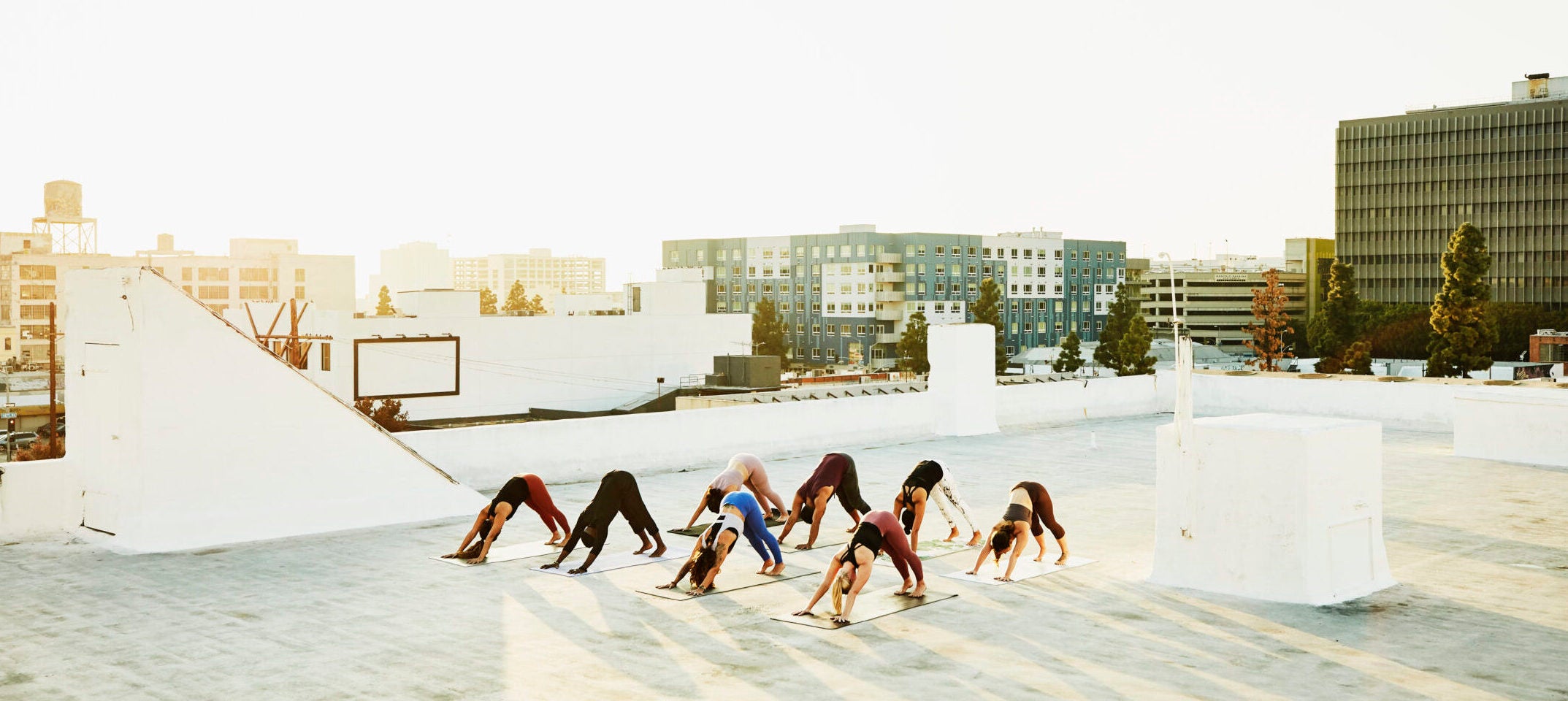
Elevated view of yoga class in downward dog pose on rooftop at sunset (Photo: Getty Images)
Downward-Facing Dog presents some curious challenges. Its complexity can be disorienting for beginners, yet those familiar with it sometimes regard it as nothing more than a breather in between other poses.
But bring a sense of exploration to Down Dog, or Adho Mukha Svanasana, and you’ll quickly learn ways that you can expand its potential. Whether it’s your first or your five-hundredth time in the posture, the following variations can help you understand that how you show up to the shape can bring you even more of what you need, whether upper body strengthening, hamstring stretching, or knowing how to engage in more challenging poses.
20 Ways to Change Up Your Down Dog
Any time we reduce our contact with the floor, we increase the demand on muscles that maintain our stability. Playing with one-arm or one-leg versions of down dog gives us multiple possibilities to explore in that vein, including those that add to our mobility as well as our stability.
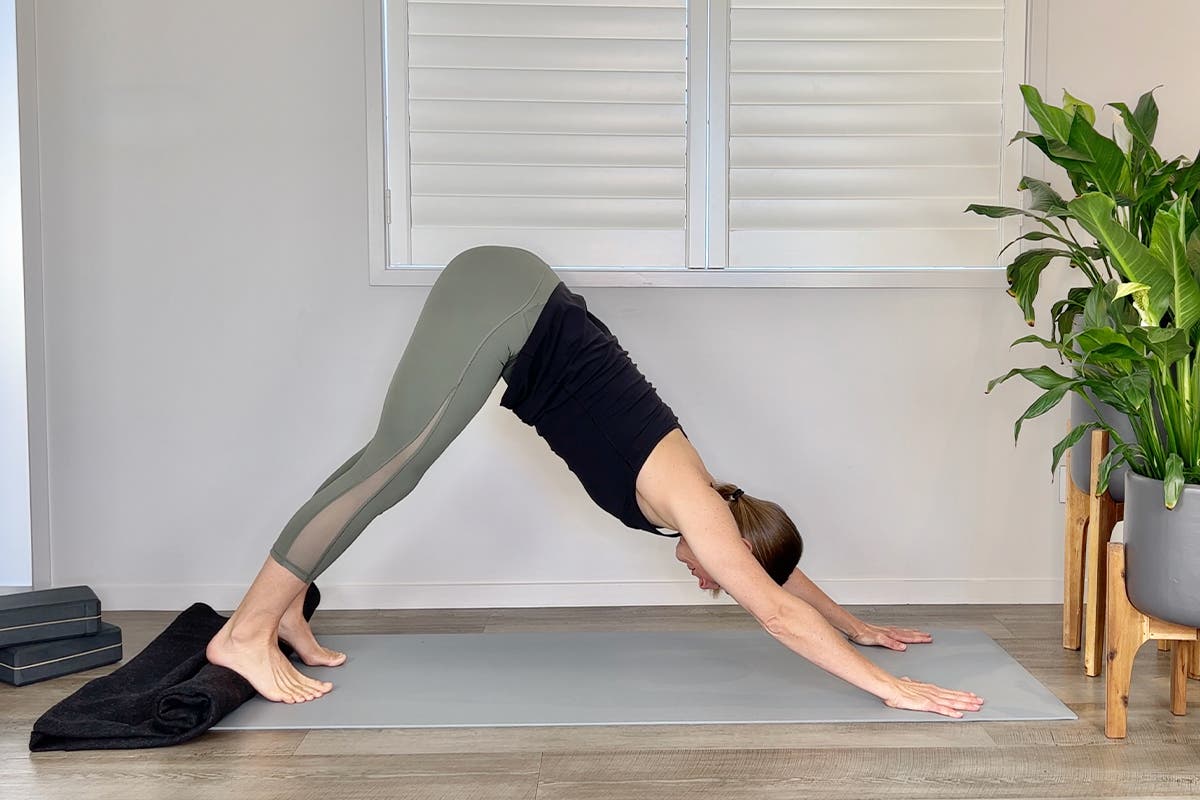
1. Heels Supported
Pressing your heels against something in Down Dog brings an element of stability by shifting the load from your upper body toward the larger muscles in your lower body. It also brings some extra intensity to the calf stretch.
But no matter how long or hard you try, your heels may not reach the mat. That could be due to your unique ankle anatomy or your flexibility in your calves or hamstrings or any number of reasons. And that’s perfectly fine. This propped version of the pose lifts the floor to meet you. It can help anyone connect with engagement of the legs and feet, which is helpful practice for the back leg in poses like Virabhadrasana I (Warrior 1) and Parsvottanasana (Pyramid Pose).
How to: Position a firmly rolled yoga mat, a folded or rolled blanket, or even a yoga block beneath your heels. Press your feet firmly into the prop.
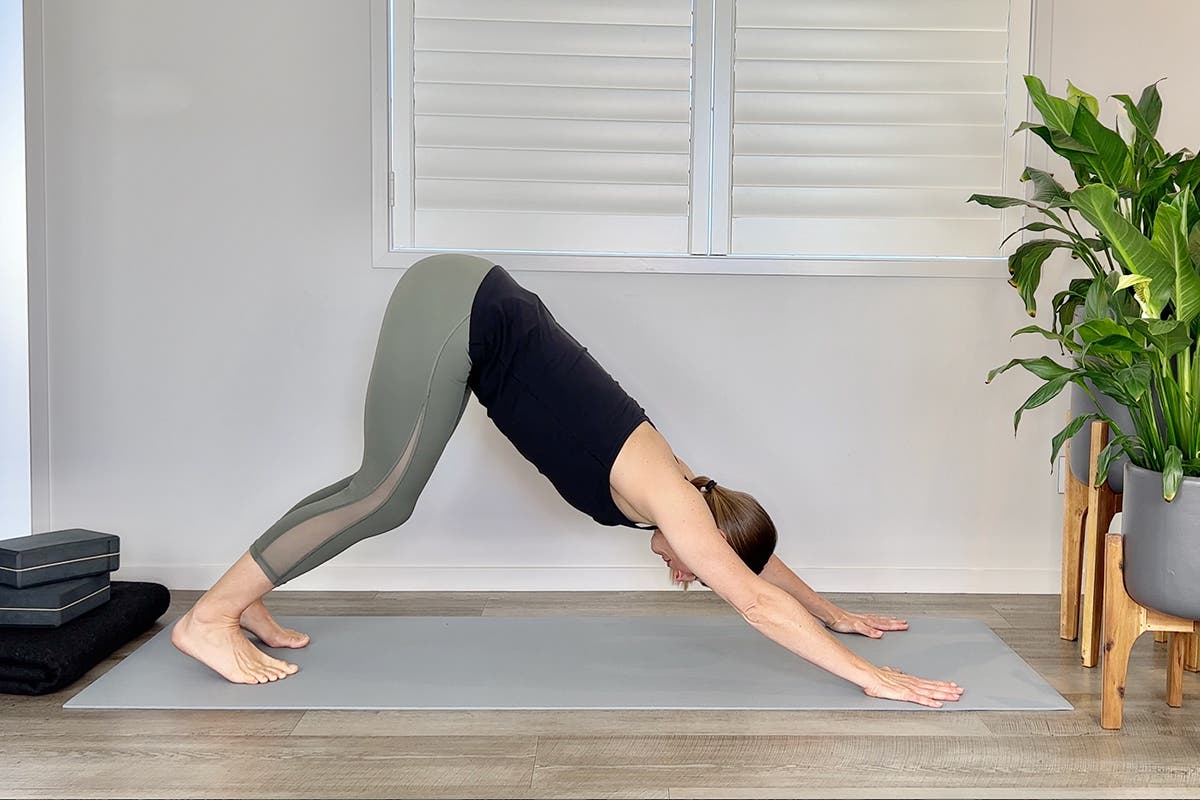
2. Knees Bent
Bending your knees is commonly offered in Down Dog as an option to relieve hamstring tension. But what’s rarely discussed is how much of a bend.
How to: The degree of knee bend creates profound shifts in your experience of the pose. What results are completely different versions of the pose that achieve completely different results.
Bend your knees slightly to place just enough slack on your lower hamstrings to mobilize your upper hamstrings. This allows you to lift your sit bones rather than round your low back.
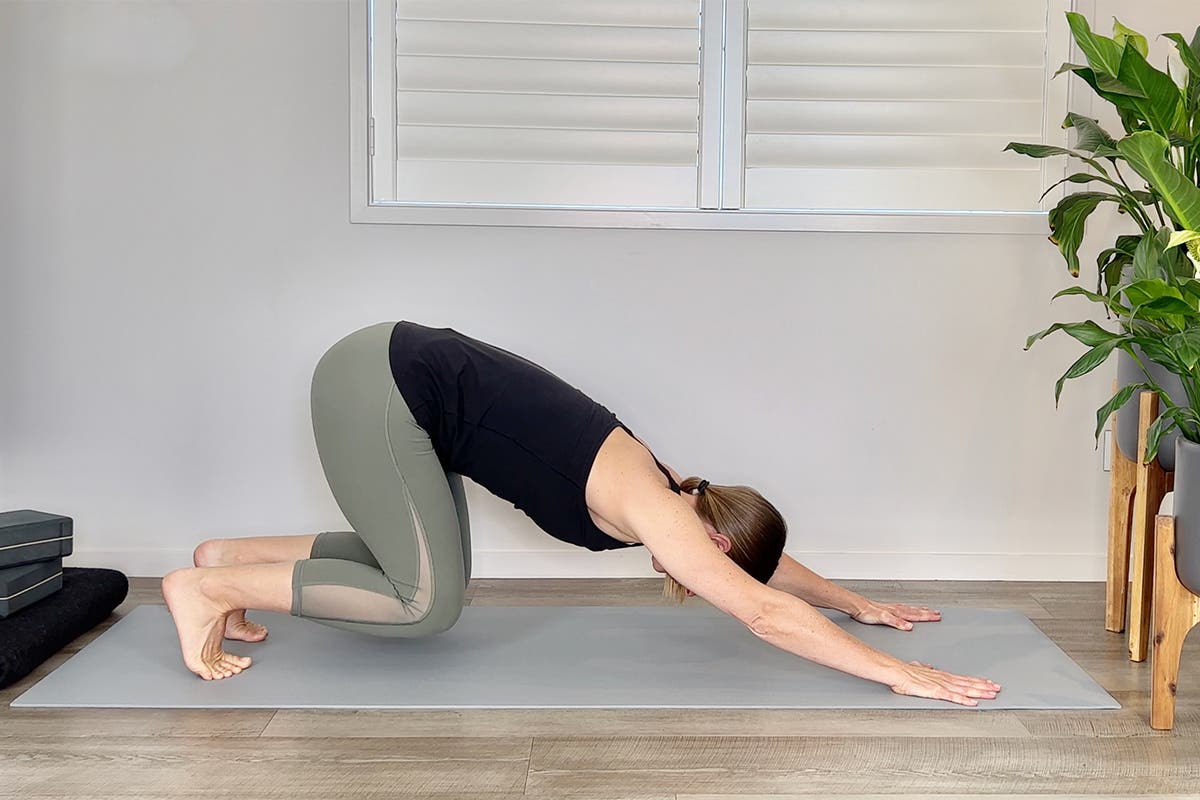
Bend your knees deeply while pressing your chest toward your thighs (sometimes called Bear Pose) to forget all about your hamstrings and focus your attention on the added work in your arms, chest, and quads.
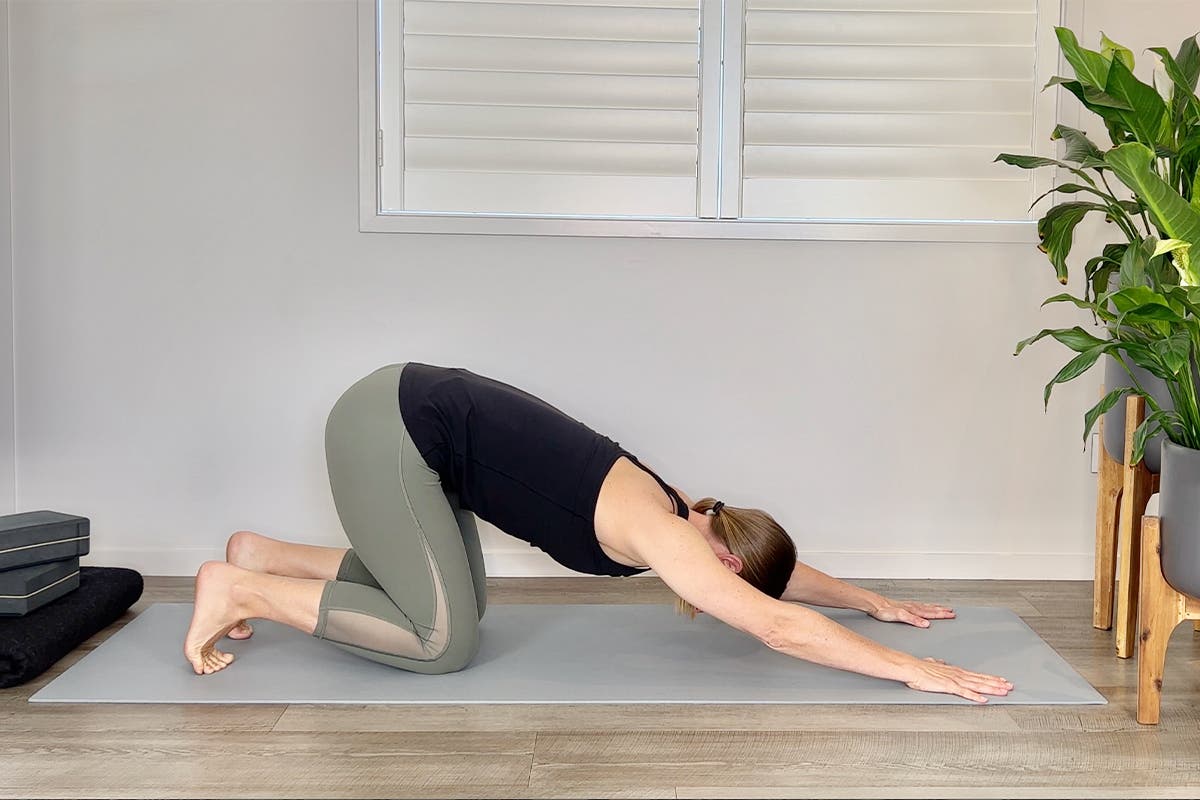
Bend your knees all the way to the mat and take Uttana Shishosana or Anahatasana (Puppy Pose)—also known as Uttana Shishosana. This alternative entirely bypasses the lower body work to focus on opening your chest and shoulders.
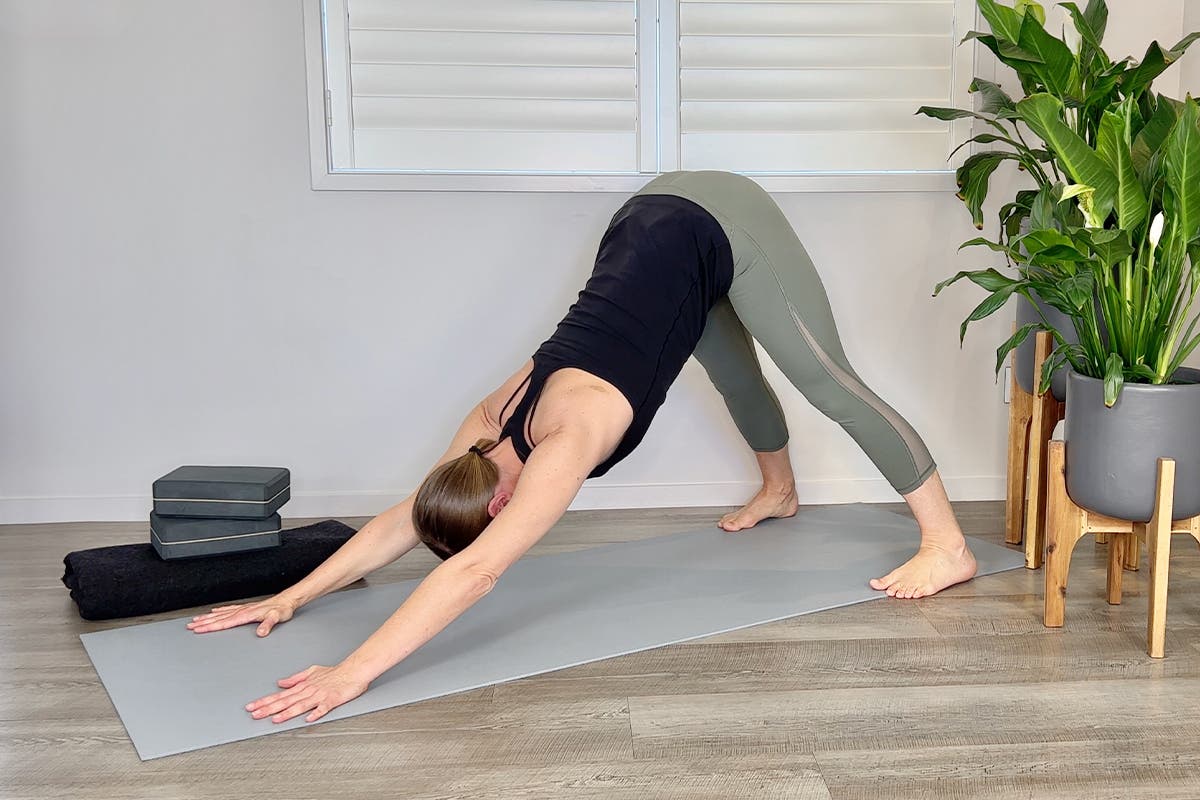
3. Feet Wide
If tight hamstrings make your Down Dog difficult, switch up the standard alignment of feet hip-width apart and take a wide leg position. This shifts the intensity of the stretch from the commonly tight lateral hamstrings (the biceps femoris, for anatomy geeks) to the usually less tense medial hamstrings (semimembranosus and semitendinosus).
Practicing this version of Down Dog also sets you up to find less challenge in wide-legged forward folds, such as Prasarita Padottanasana.
How to: From Down Dog, walk your feet mat-width apart or, if it feels more comfortable, take them past the edges of your mat.
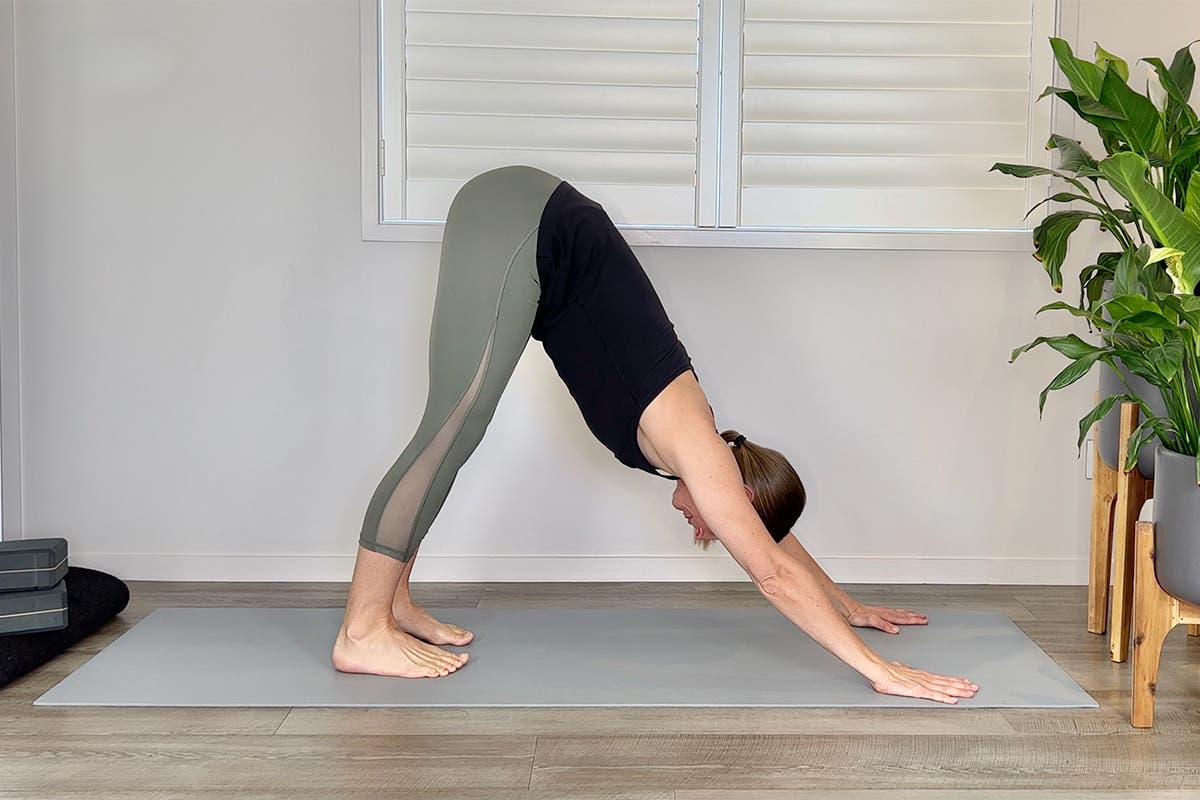
4. Short Dog
Want to experience more of a hamstring stretch? Or prep for coming into Handstand (Adho Mukha Vrksasana)? Up the intensity on your Down Dog by shortening the length of your dog so it feels more like Uttanasana (Standing Forward Bend).
How to: From Down Dog, walk your hands and feet closer to each other, stopping when you feel the desired length down the backs of your legs.
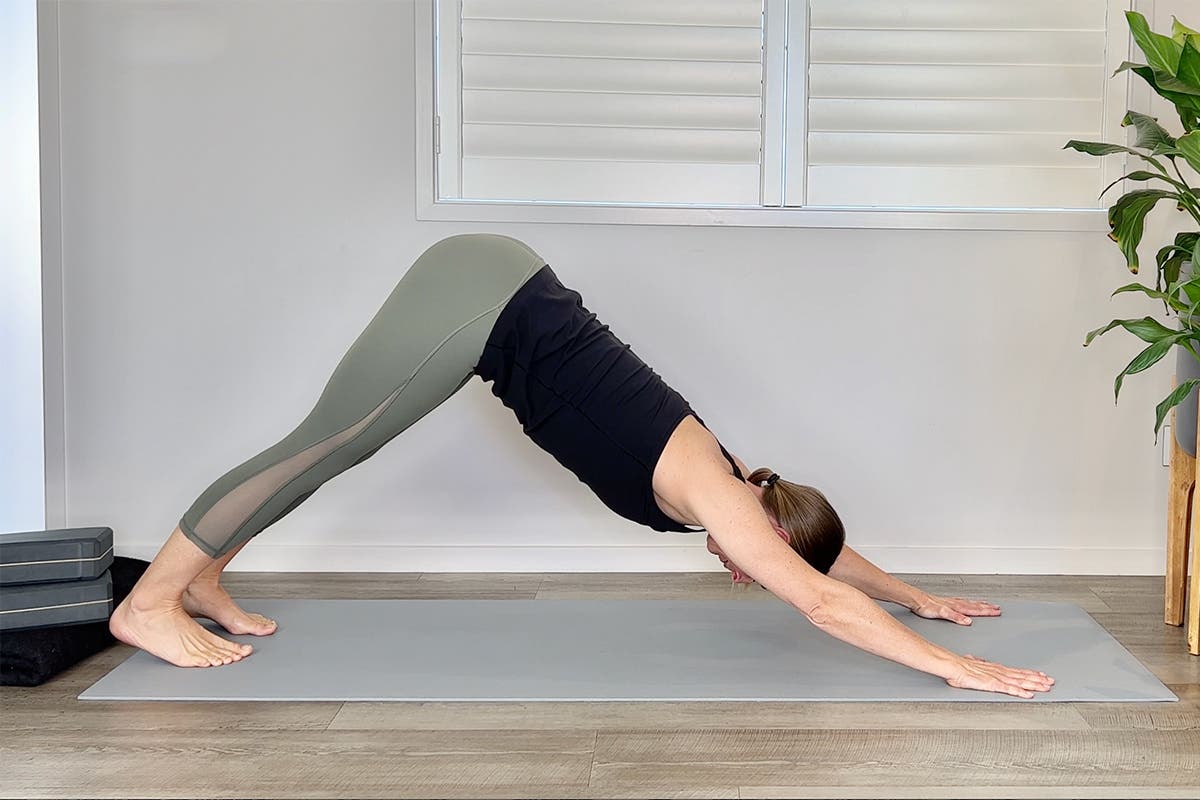
5. Long Dog
If you prefer to focus on upper body and core strength, lengthen your dog and shift it a little forward so that it feels closer to practicing Plank.
How to: From Down Dog, try walking your hands and feet further away from each other, stopping when you feel the desired challenge to your strength.
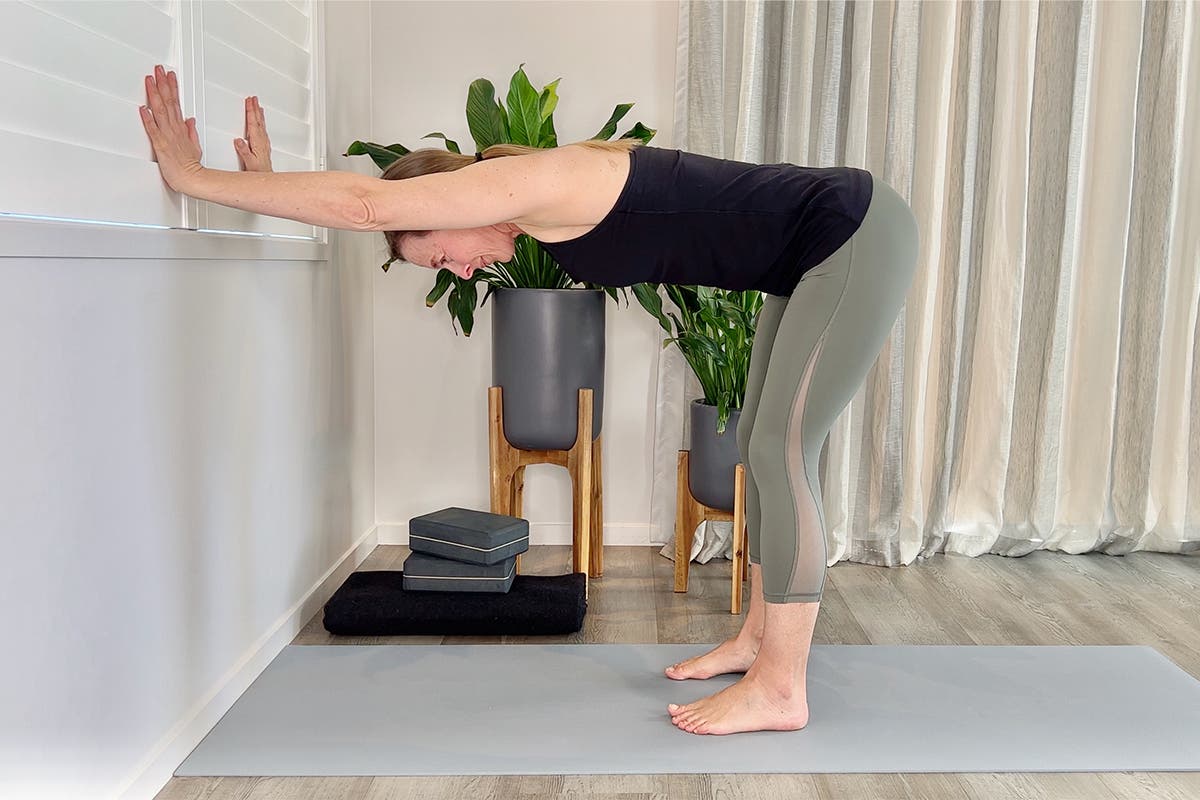
6. Wall Dog
If you’re interested in working on chest and shoulder mobility rather than strength, remove upper body strength from the equation by taking your dog to a wall.
How to: Stand facing a wall. Place your hands on it at about shoulder height and width. Fold forward at your hips, walking your feet away from the wall and your hands down the wall until your arms and upper body are horizontal at hip height. Soften your knees and your neck, and let gravity help you release your chest through your upper arms toward the floor, similar to the sensation you feel in Puppy Pose.

7. Dog to Dolphin
Try this if you want to focus on building upper body strength, especially if you’re training for arm balances such as Sirsasana (Headstand) or Pincha Mayurasana (Forearm Balance). Either way, this variation shifts your center of gravity, and therefore the strength requirement, toward your upper body.
How to: From Down Dog, bring your elbows and forearms down to the floor at shoulder width for Dolphin Pose. You can pres your palms into the mat or press them together in prayer position (Anjali mudra).
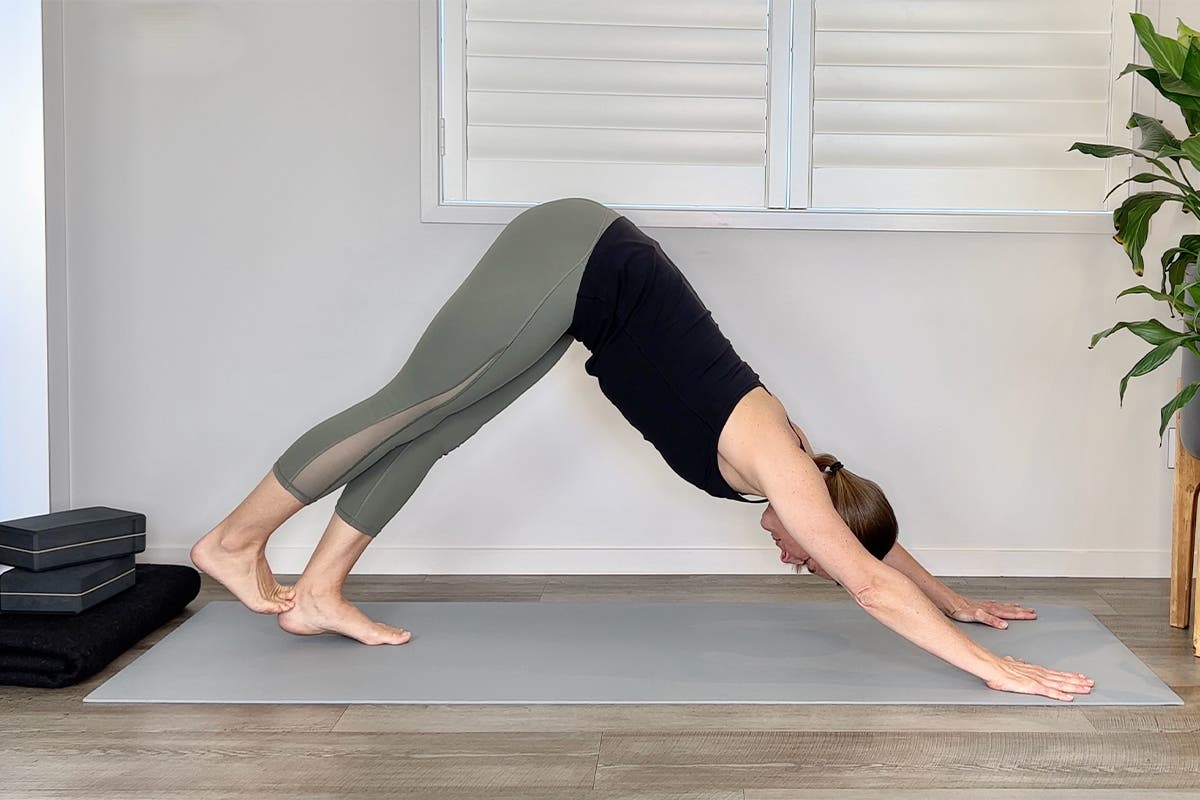
8. Dog With Assisted Calf Stretch
You can use the weight of one leg to add intensity to the calf strength in the other. You might even find your heels stretch a little closer to the mat afterward.
How to: From Down Dog, lift one leg and press the ball of that foot against the heel of your standing leg. Do the same stretch on your second side.

9. Pigeon Stretch or Figure 4
This variation provides a welcome stretch and helpful prep for poses that require a similar hip position, including Eka Pada Rajakapotasana (Pigeon Pose) and the arm balances Eka Pada Galavasana (Flying Pigeon) and Maksikanagasana (Grasshopper or Dragonfly).
How to: From Down Dog, lift one foot, bend your knee, and draw it toward your chest. Rest your outer ankle above the knee of your standing. Bring your bent knee out wide in a figure-4 shape and lean your chest toward your lower body to find a satisfying outer hip stretch. Pause for a breath or two before swapping sides.
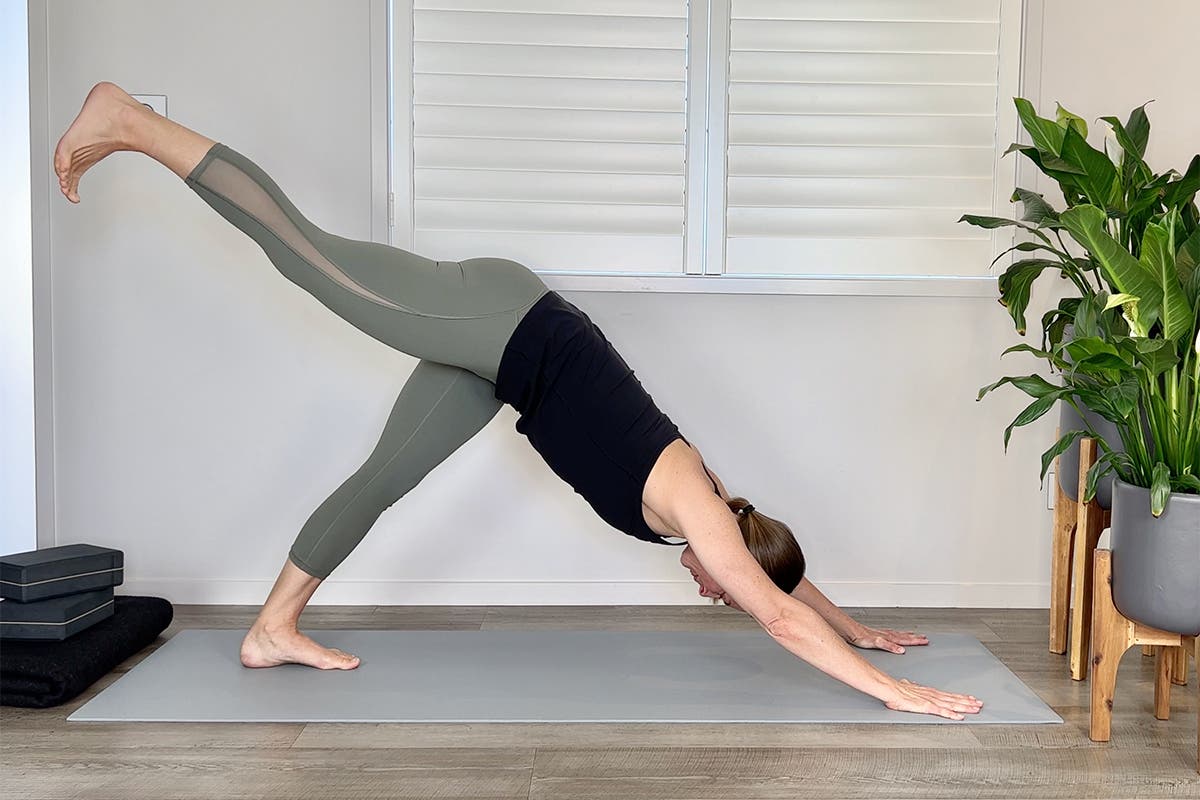
10. Straight Leg Lift
Lifting one leg in Down Dog while keeping your hips square to the mat builds glute and hamstring strength. It also helps you practice the alignment you need in more challenging poses like Virabhadrasana III (Warrior 3) and Victory Pose (the hands-free version of Utthita Hasta Padangusthasana or Extended Hand-to-Big-Toe Pose).
How to: From Down Dog, lift one leg straight back behind you in Three-Legged Dog while keeping your hips square to your mat. Your leg won’t lift as high as it would if you stacked your hips, but the effort will remain centered around the sit bone of your lifting leg.
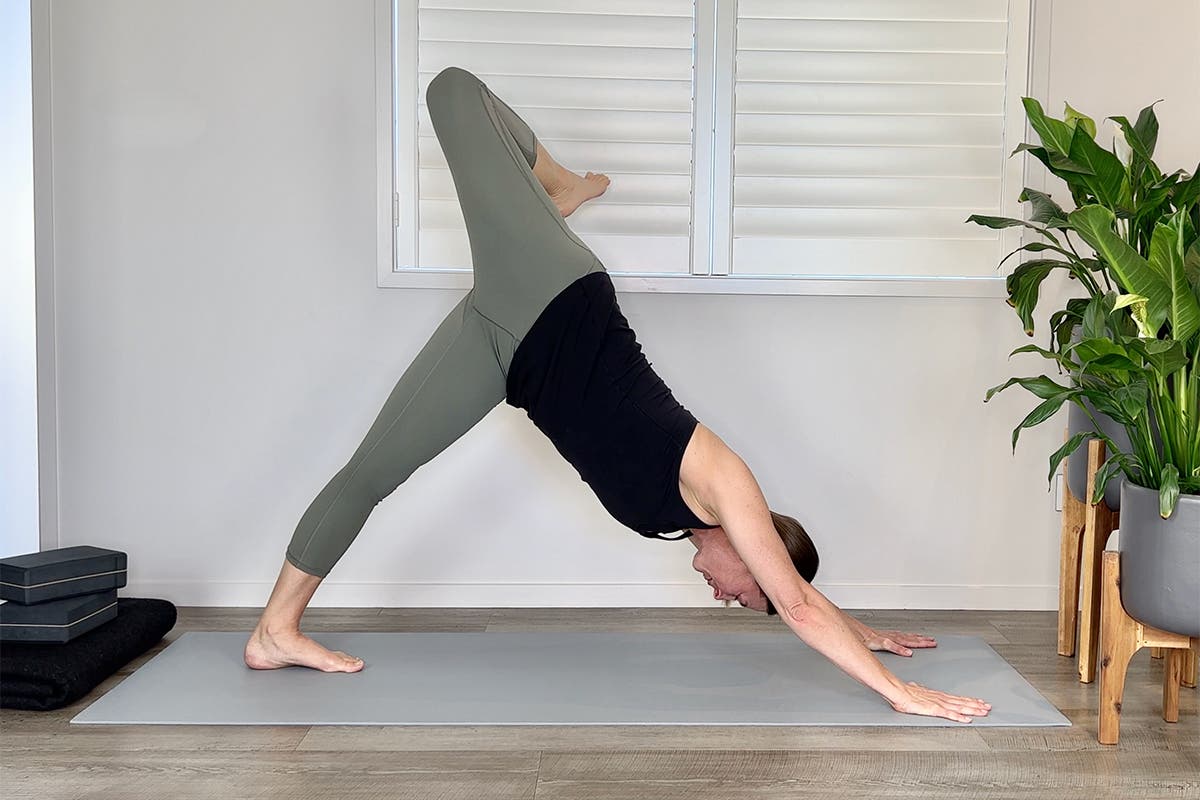
11. Open-Hip Leg Lift
This variation of Three-Legged Dog highlights mobility in the hamstrings and inner thigh of your standing leg. It sets you up for standing poses that face the long side of the mat, such as Utthita Parsvakonasana (Extended Side Angle).
How to: From Down Dog, lift one leg and sweep it up and back toward the ceiling. Turn your hips in the direction of the raised leg to help lift it higher. You can keep your lifted leg straight and reach through your toes, or bend your knee and let your heel fall toward your sit bone.
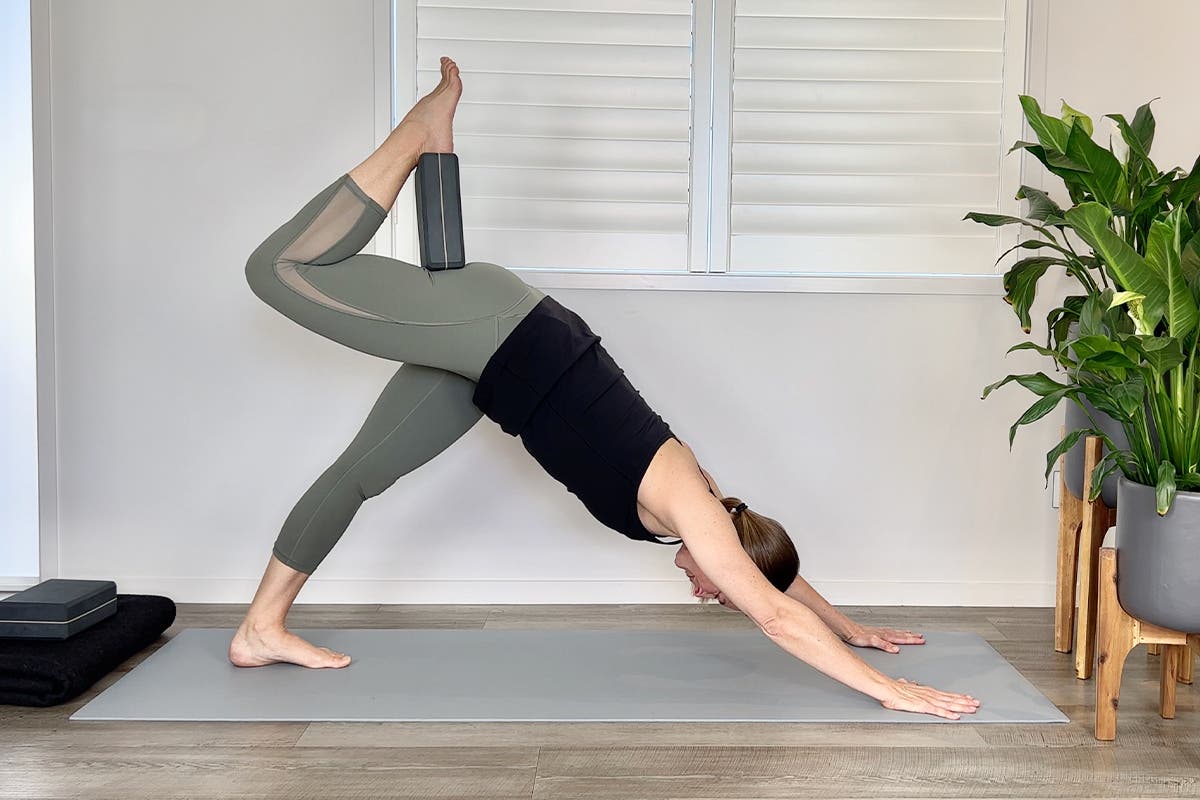
12. Hamstring Squeeze
Yoga doesn’t offer many hamstring strengthening options. This variation brings some balance to that equation by forcing you to engage your hamstrings and glutes by squeezing a block between your heel and the same-side sit bone.
How to: Start on all fours to position the block between the back of one heel and the same-side sit bone. Contract the back of that leg to keep the block snug in place as you lift into a one-leg Down Dog on your other leg. Slowly lift your bent knee as high as you can while keeping your hips square to the mat. Feel the muscles around your sit bone and down the back of your bent leg engage. Stay here for a couple of slow breaths before returning to all fours. Swap sides.
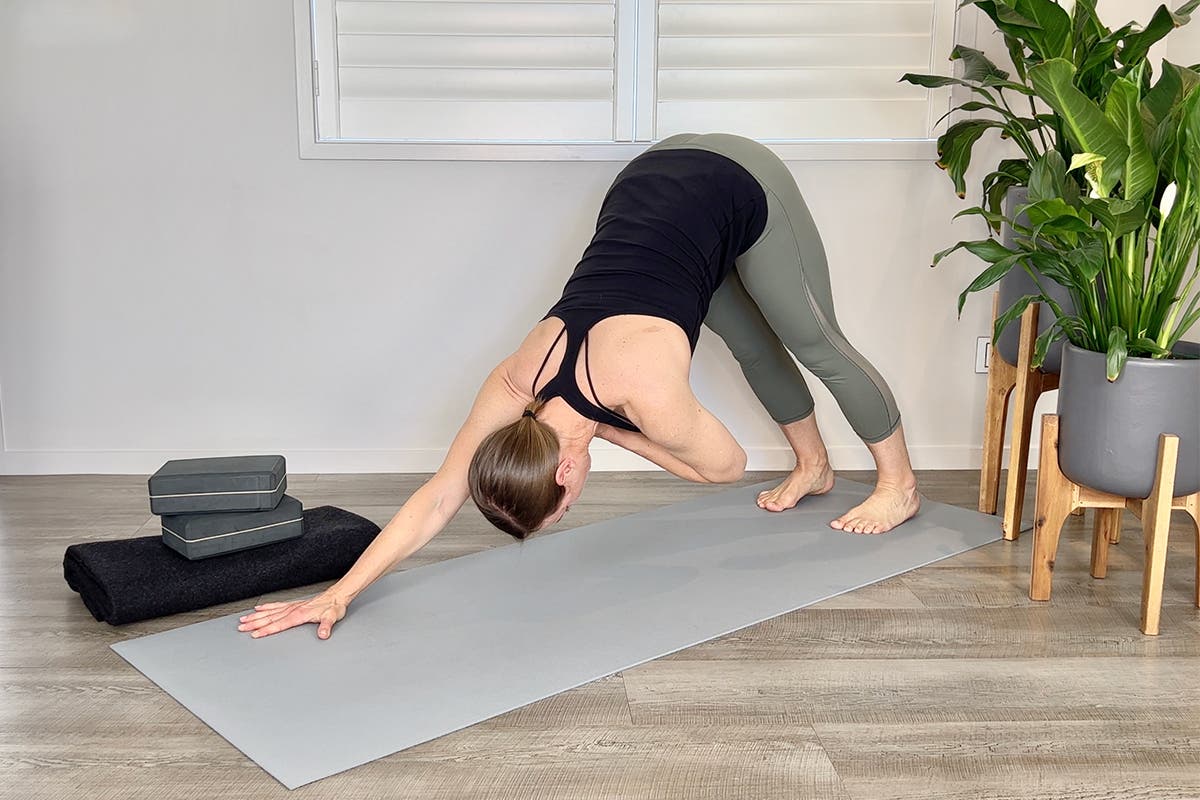
13. Shoulder Taps
Lifting one hand off the mat in Down Dog challenges you to work on finding shoulder stability while your arms are overhead, which are the same actions and alignment that will keep you steady in Handstand. This action can also highlight imbalances between your left and right sides.
How to: From Down Dog, float one hand off the mat and touch your opposite shoulder, keeping your chest square to your thighs and the mat. Pause to hug the shoulder of your supporting arm against your side ribs and soften the sides of your neck before smoothly swapping sides.
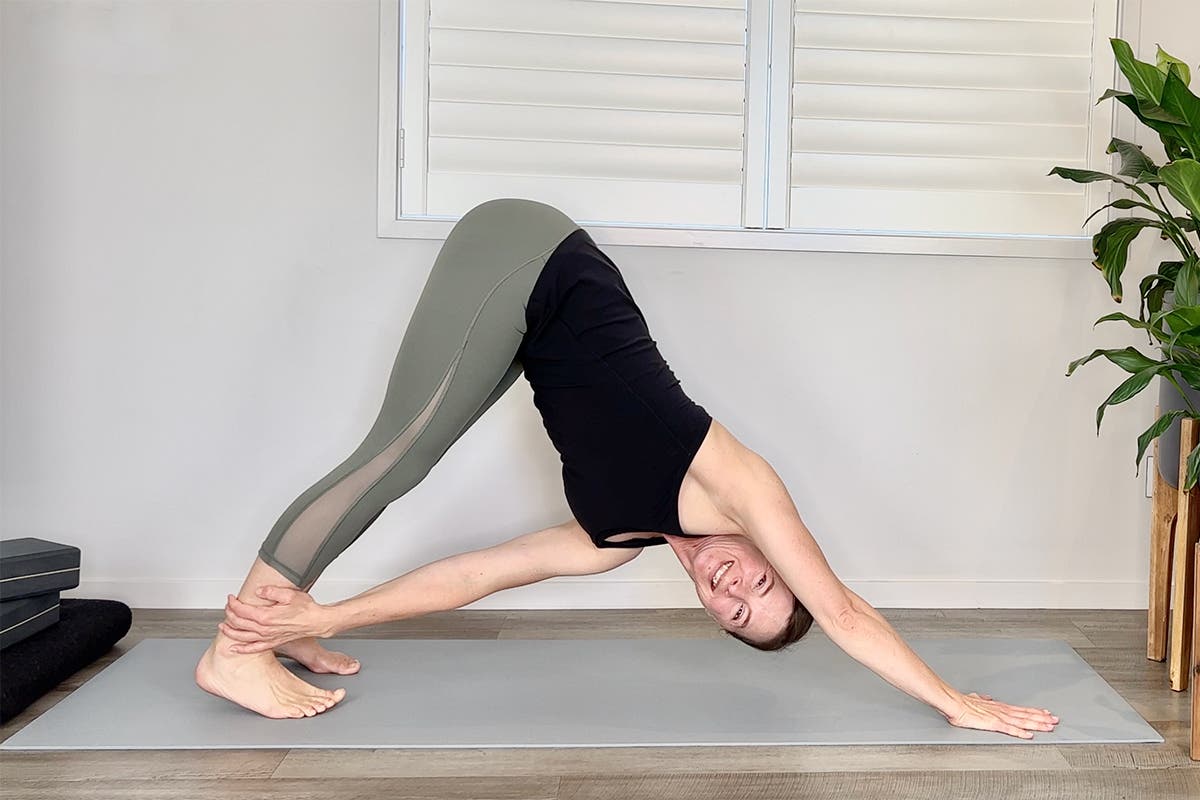
14. Down Dog Twist
This variation takes the upper body strength requirement of shoulder taps and adds rotation of the torso. This prepares you for the flexibility demanded by Utthita Parivrtta Hasta Padangusthasana (Standing Twist) and for the combination of twist and arm strength demanded by the arm balance Eka Pada Koundinyasana I.
How to: From Down Dog, float one hand and actively stabilize your support shoulder as in Shoulder Taps (above). Reach underneath your body for the ankle of your opposite leg and use the bind to help you twist and draw your chest toward the long edge of the mat through the space between your arms. Take a breath or two there, lengthening your midline, before slowly returning to Down Dog. Swap sides.
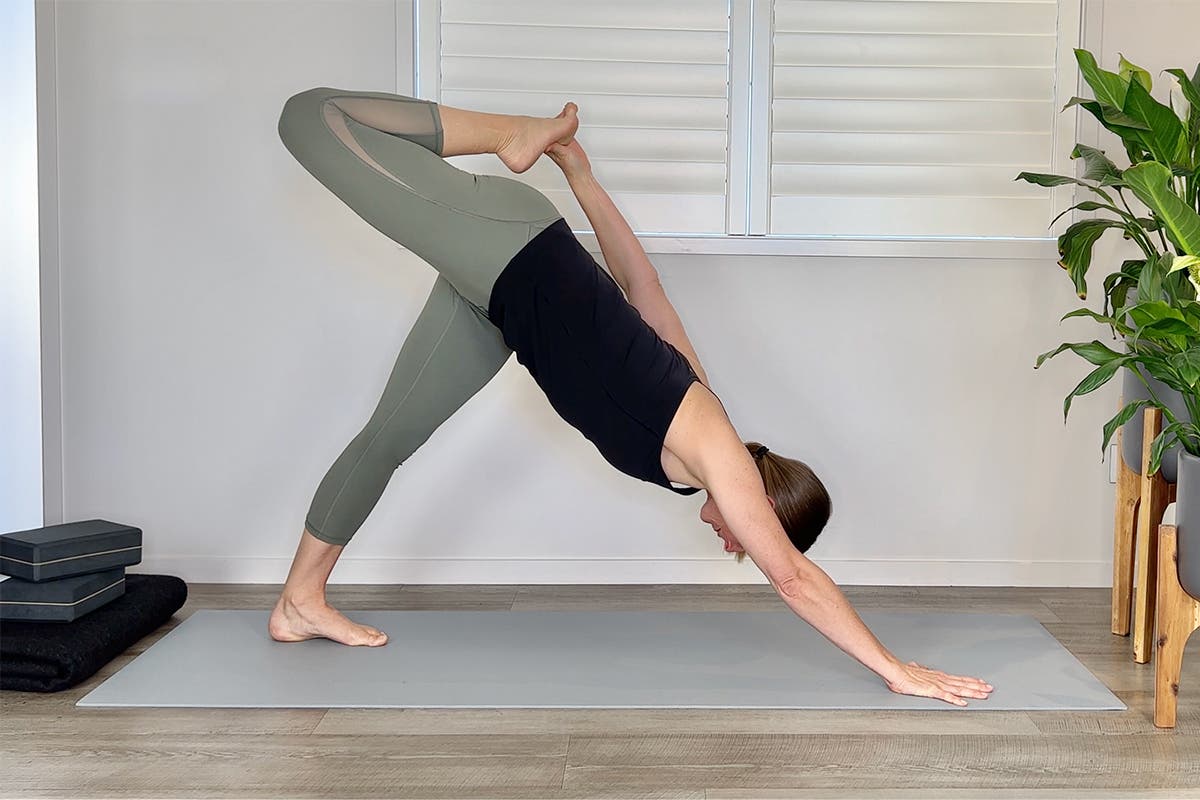
15. Down Dog with a Bind
If lifting an arm or a leg in Down Dog challenges the stability of your dog, lifting an arm AND a leg doubles that challenge. Or perhaps it exponentially ups it. This version of Downward Dog makes Natarajasana (Dancer Pose) feel comparatively easy.
How to: From Down Dog, lift one leg behind you as you keep your hips steady and square to the mat. Slowly float your opposite hand off the mat and reach it alongside your body toward the back of the mat. Keep your gaze steady on your grounded foot as you bend your lifted knee and bring that foot and your lifted hand to touch behind your sacrum. Once you grasp your foot, pause to soften the sides of your neck and your breathing before releasing the bind and coming back to Down Dog. Repeat on your second side.
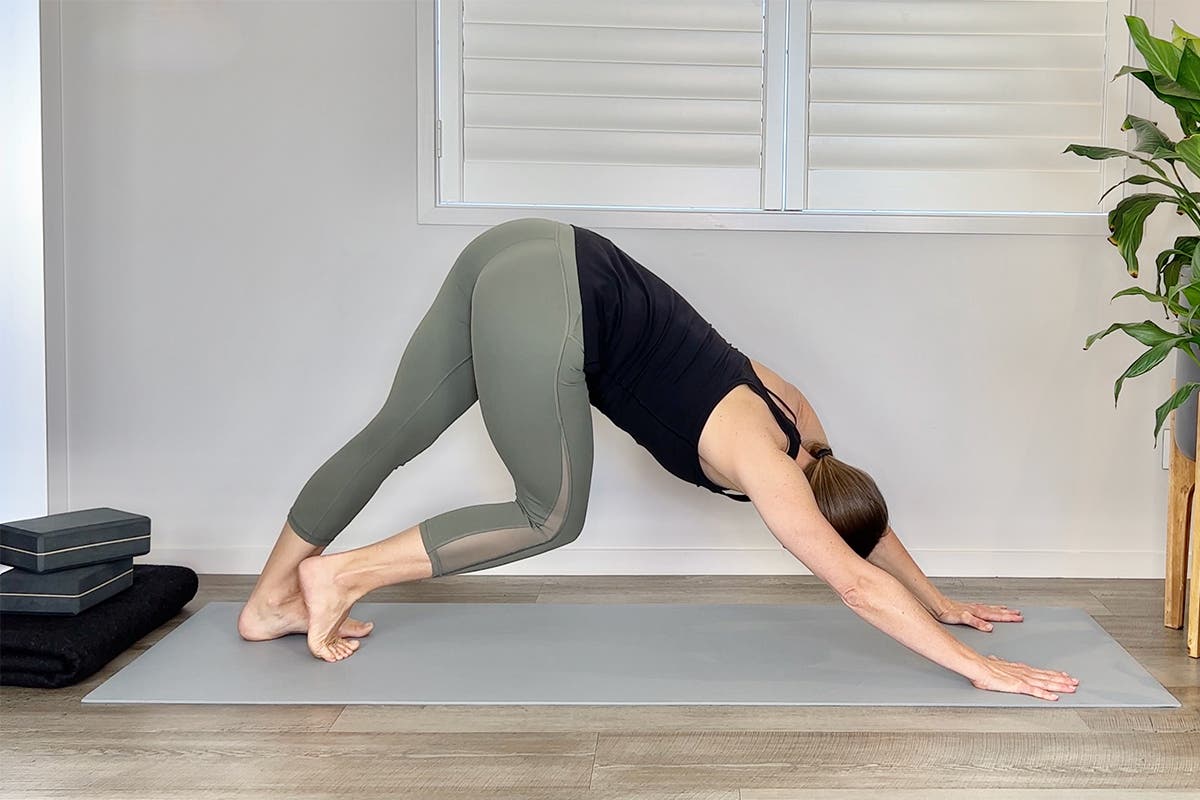
16. Walk Your Dog
Perhaps the best way to loosen your grip on alignment ideals is to introduce movement to a posture, which shifts your focus from precision to exploration. It also offers a gentle whole-body wake-up in that first Down Dog of the day.
How to: From Down Dog, simply press down through one heel while you bend your opposite knee and come onto those toes. As you shift from side to side, slowly pedaling your feet, you can even let the hip of your bent leg dip to sway your body a little from side to side.
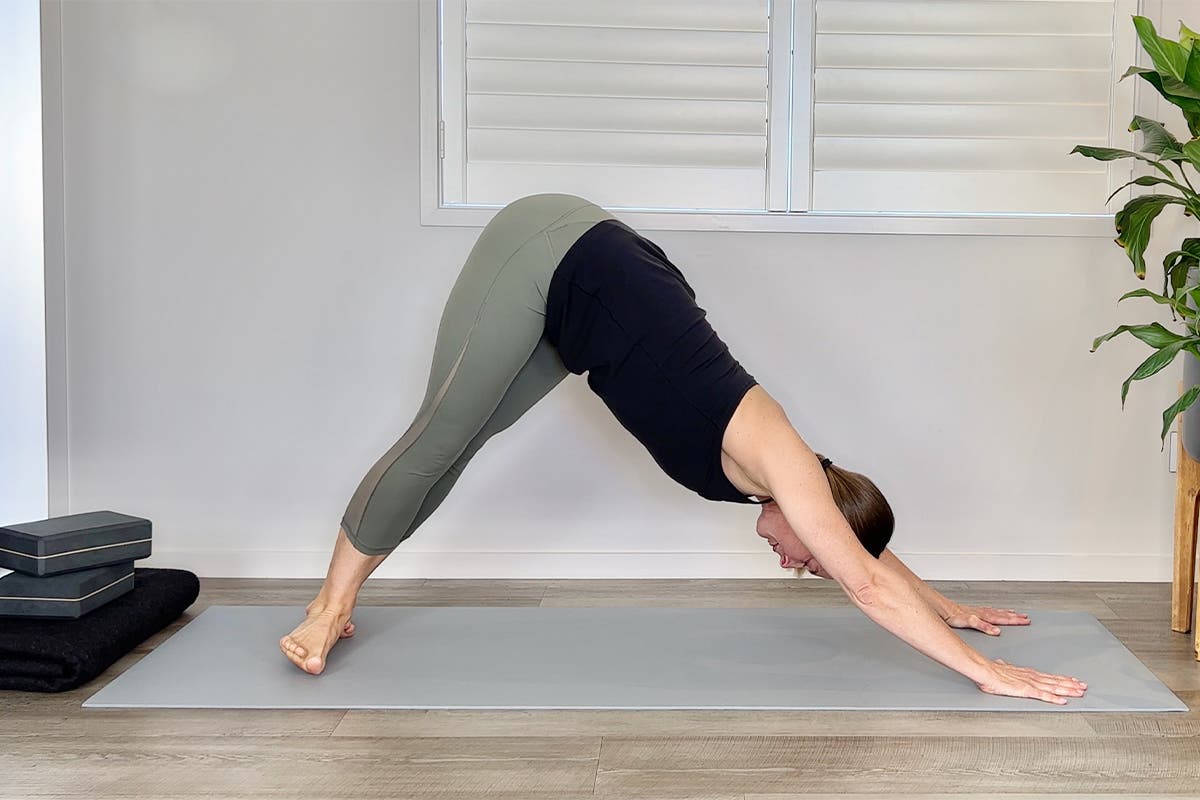
17. Roll Your Feet
In this Down Dog variation, you’ll roll your feet from side to side, shifting from the big-toe edge to little toe edge and generating mobility in the feet, ankles, outer hips and side body along the way.
How to: From Down Dog, lift onto your tiptoes then pivot on the balls of your feet to point your toes toward the right long side of your mat. You’ll be on the inner edge of your leading (right) foot and the outer edge of your trailing (left) foot. Lean the outer hip of your leading leg toward the back of your mat to lengthen your side body and outer hip. Pivot on the balls of your feet to come back to center. Repeat on your second side.
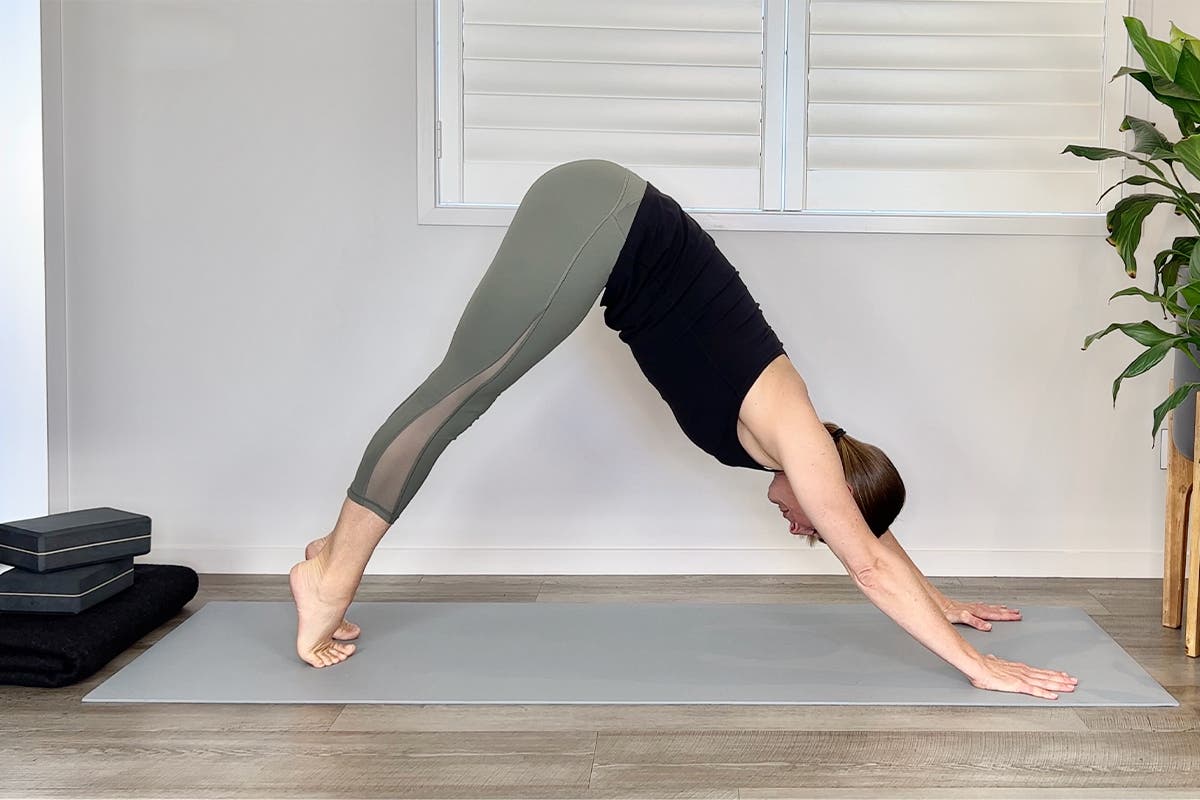
18. Tiptoes to Knee Bends
Moving between straight legs and bending your knees wakes up your calf muscles and the plantar fascia along the soles of your feet. It also warms up your shoulders, knees, and quads.
How to: From Down Dog, lift your heels high, then deeply bend your knees and press your chest toward your thighs in Bear Pose. Keep that shape in your upper body as you straighten your legs and lift your heels, then press your heels toward the floor and come back to Down Dog before repeating the movement.
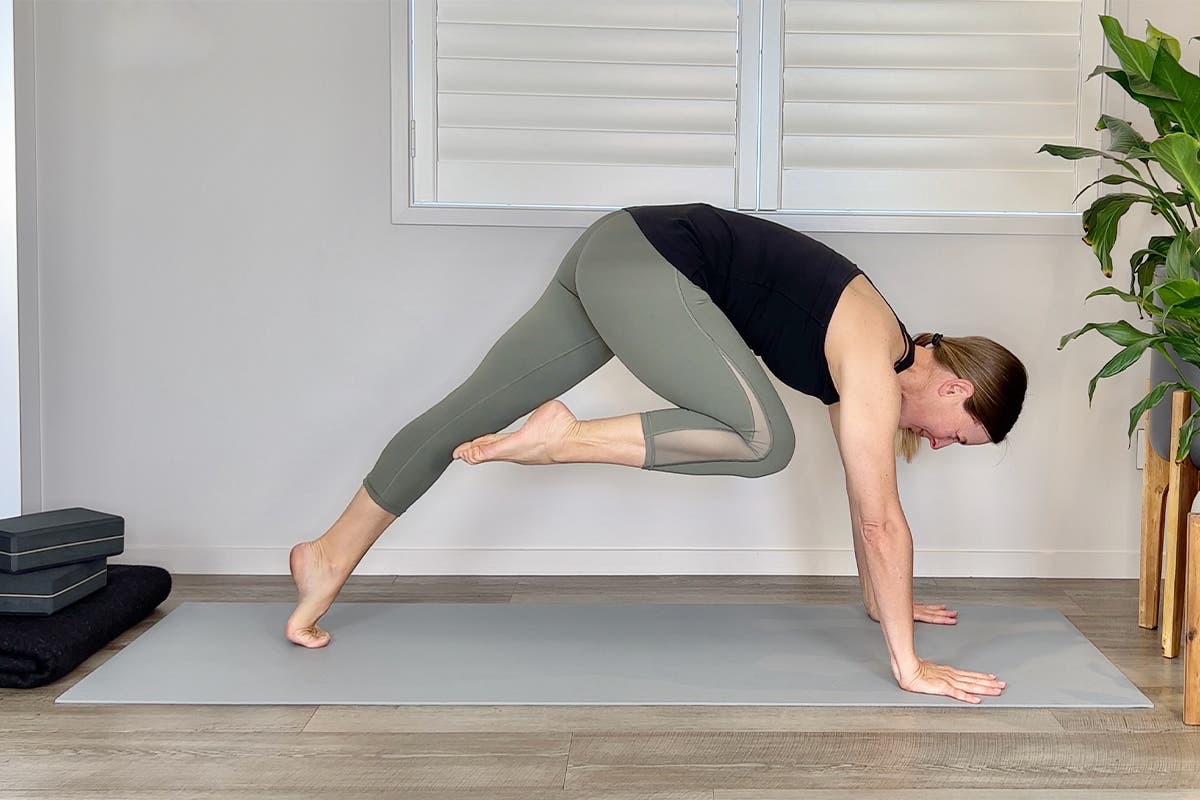
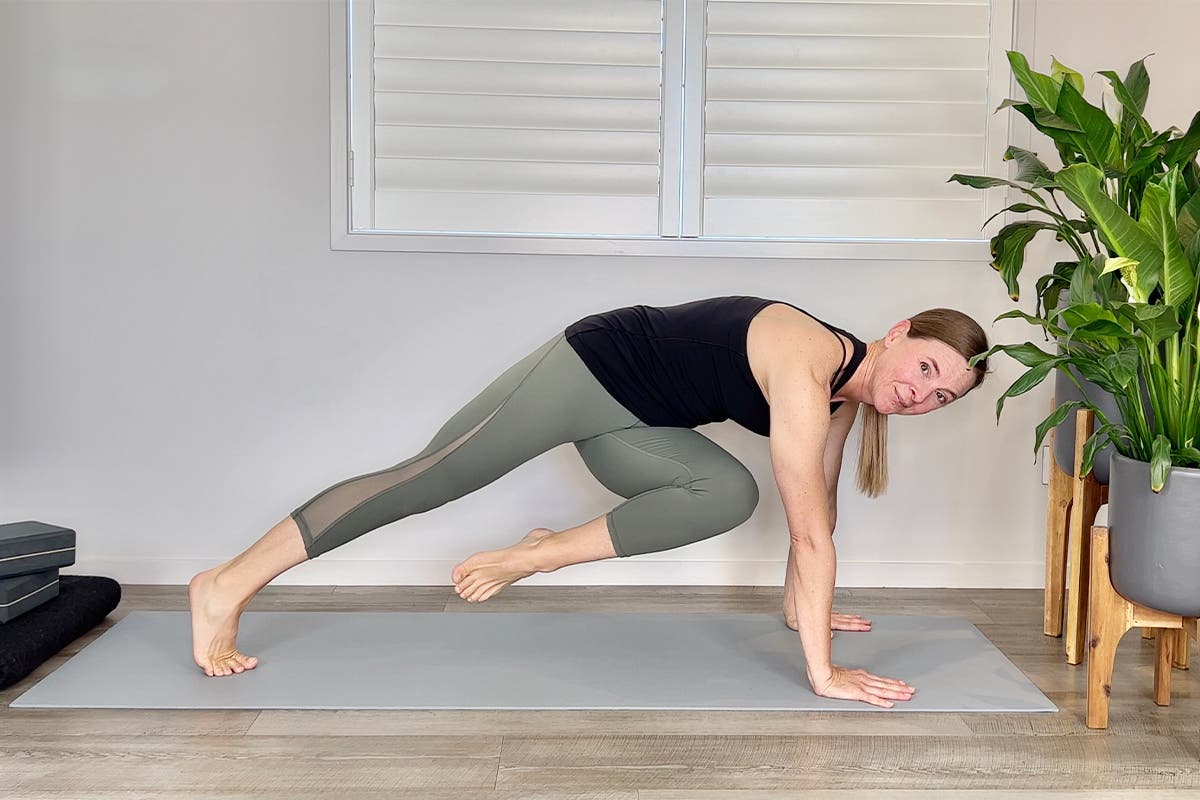
19. Crunches
You’ll build strength in the abdominals, hip flexors, and chest with this Down Dog variation. It doubles as prep for arm balances such as Bakasana (Crow or Crane) and Eka Pada Bakasana (Flying Crow).
How to: From Down Dog, lift one leg behind you, bend your knee, and draw it toward your chest or either elbow as you shift your shoulders forward and stack them over your wrists. Scoop your belly and squeeze your knee close to add extra front body engagement. Then shift your hips back and up as you sweep your leg straight behind you in Three-Legged Dog and then lower your leg into Down Dog. Repeat on the other side.
20. Pike Push-Ups
For many of us, push-ups are a familiar option from Plank Pose. But they take on an entirely different dimension when practiced with your hips piked or lifted. That increase in effort is thanks to an increased percentage of your body weight that’s supported by your arms. You’ll feel the heat build quickly with either of the following variations, which can help you build the strength you need to stay longer in arm balances and inversions.
How to: You can practice Down Dog push-ups a couple of ways:
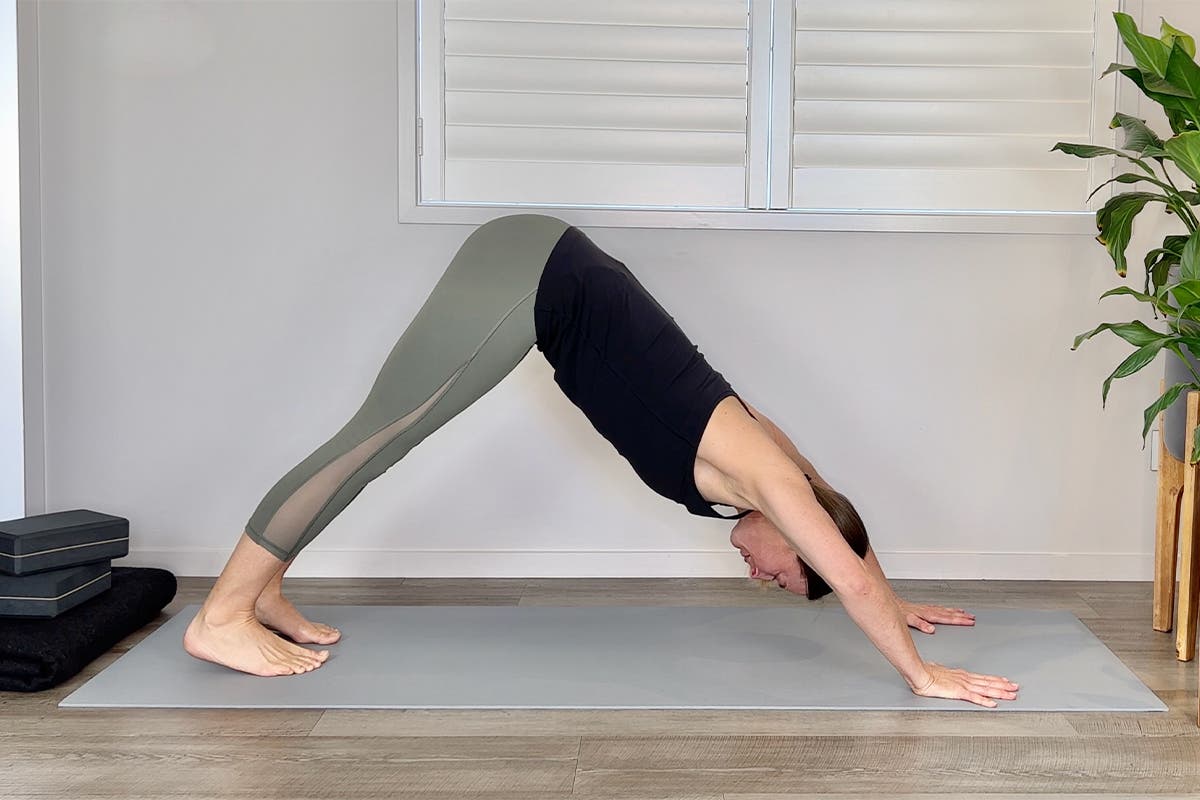
1. From Down Dog, bend your elbows and allow them to come out to the side before straightening them again. This recruits a little more support from your pecs, which are your largest chest muscles.
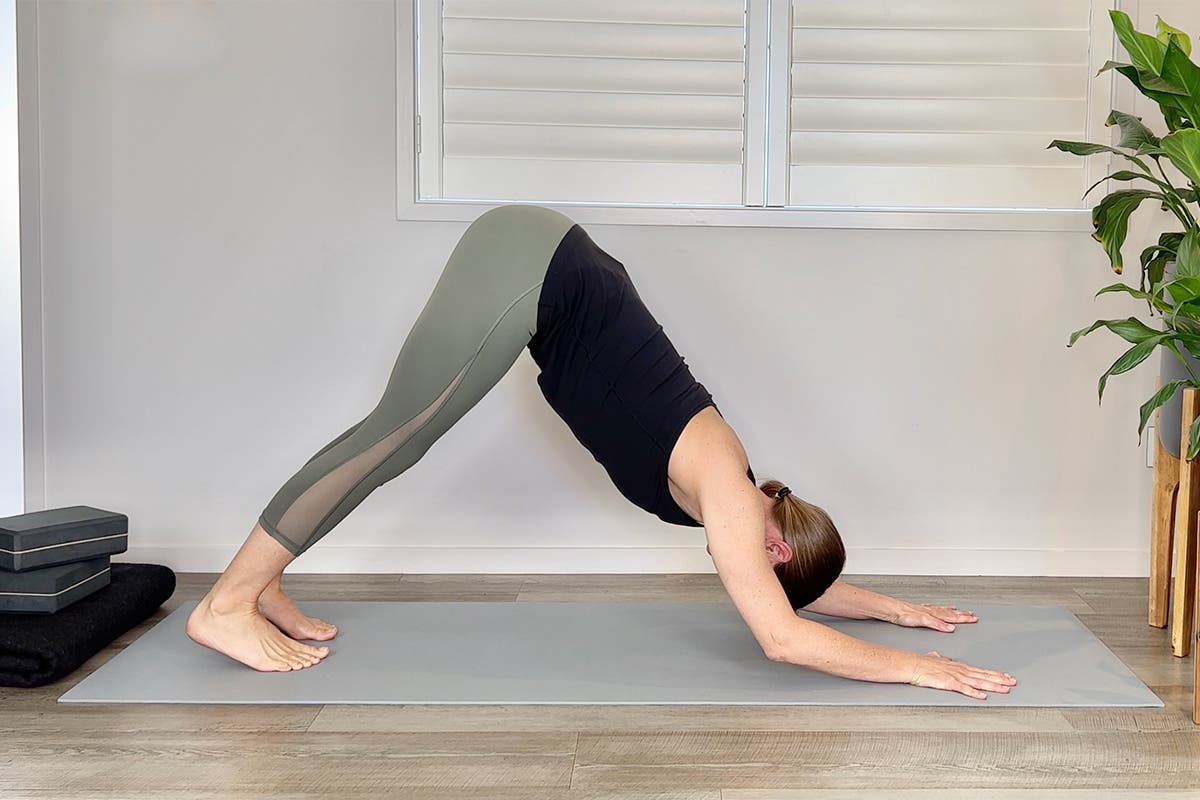
2. From Down Dog, keep your elbows shoulder-width as you bend and straighten your arms, much like in Chaturanga, honing in on your triceps along the backs of your upper arms.
RELATED: 17 Cues for Downward-Facing Dog You’ve Probably Never Heard Before
About Our Contributor
Rachel Land is a Yoga Medicine instructor offering group and one-on-one yoga sessions in Queenstown New Zealand, as well as on-demand at practice.yogamedicine.com. Passionate about the real-world application of her studies in anatomy and alignment, Rachel uses yoga to help her students create strength, stability, and clarity of mind. Rachel also co-hosts the new Yoga Medicine Podcast.